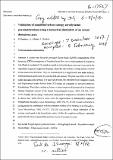Validation of Simplified Urban-Canopy Aerodynamic Parametrizations Using a Numerical Simulation of an Actual Downtown Area
Author(s)
Ramirez, N.; Afshari, Afshin; Norford, Leslie Keith
Download10546_2018_345_ReferencePDF.pdf (1.620Mb)
Open Access Policy
Open Access Policy
Creative Commons Attribution-Noncommercial-Share Alike
Terms of use
Metadata
Show full item recordAbstract
Abstract
A steady-state Reynolds-averaged Navier–Stoke computational fluid dynamics (CFD) investigation of boundary-layer flow over a major portion of downtown Abu Dhabi is conducted. The results are used to derive the shear stress and characterize the logarithmic region for eight sub-domains, where the sub-domains overlap and are overlaid in the streamwise direction. They are characterized by a high frontal area index initially, which decreases significantly beyond the fifth sub-domain. The plan area index is relatively stable throughout the domain. For each sub-domain, the estimated local roughness length and displacement height derived from CFD results are compared to prevalent empirical formulations. We further validate and tune a mixing-length model proposed by Coceal and Belcher (Q J R Meteorol Soc 130:1349–1372, 2004). Finally, the in-canopy wind-speed attenuation is analysed as a function of fetch. It is shown that, while there is some room for improvement in Macdonald’s empirical formulations (Boundary-Layer Meteorol 97:25–45, 2000), Coceal and Belcher’s mixing model in combination with the resolution method of Di Sabatino et al. (Boundary-Layer Meteorol 127:131–151, 2008) can provide a robust estimation of the average wind speed in the logarithmic region. Within the roughness sublayer, a properly parametrized Cionco exponential model is shown to be quite accurate.
Date issued
2018-02-27Department
Massachusetts Institute of Technology. Department of ArchitecturePublisher
Springer Netherlands